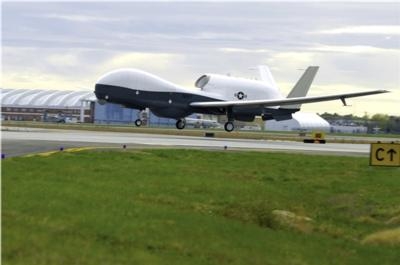Mon, Apr 27, 2015
MFAS Provides 360-Degree View Awareness Over A Large Area
The Navy’s MQ-4C Triton UAS equipped with a new search radar completed its inaugural flight April 18 over Patuxent River air space.

The radar, known as the Multi-Function Active Sensor (MFAS), is expected to greatly enhance maritime domain awareness by providing the MQ-4C with a 360-degree view of a large geographic area while providing all-weather coverage to expedite detecting, classifying, tracking and identifying points of interest.
“This first sensor flight is a huge achievement for the program,” said Sean Burke , Triton program manager. “Our Navy and Northrop Grumman team has worked extremely hard on this developmental effort, completing more than 40 surrogate flights over the last three years, and we saw the realization of that development work.”
During this initial test event, MFAS exercised its primary operating mode, known as Maritime Surface Surveillance (MSS). The MSS mode provides continuous watch over a broad area.
"Our primary objective was to test this new radar, but we also looked at how the aircraft performed as well as testing additional data links," said Lt. Cmdr. Glenn Rioux, government flight test director and senior Air Test and Evaluation Squadron (VX) 20 representative supporting the Triton integrated test team. "This was a successful flight on many levels. We are still reviewing the data and actively planning our next text event."
Along with the MFAS radar, the MQ-4C will also carry an Electro-Optical/Infrared (EO/IR) sensor that will provide still imagery and full-motion video of potential threats; an electronic support measures package to identify and geolocate radar threat signals; and an Automatic Identification System (AIS) that will detect and track vessels equipped with AIS responders.
When operational, the MQ-4C Triton UAS will provide 24/7 ISR coverage virtually anywhere in the world. Its ability to dwell at high altitudes will improve intelligence collection and bring an unprecedented level of maritime domain awareness to the warfighter operating and sustaining up to five orbits across the globe.
(U.S. Navy image)
More News
Aero Linx: JAARS Nearly 1.5 billion people, using more than 5,500 languages, do not have a full Bible in their first language. Many of these people live in the most remote parts of>[...]
'Airplane Bounced Twice On The Grass Runway, Resulting In The Nose Wheel Separating From The Airplane...' Analysis: The pilot reported, “upon touchdown, the plane jumped back>[...]
"Burt is best known to the public for his historic designs of SpaceShipOne, Voyager, and GlobalFlyer, but for EAA members and aviation aficionados, his unique concepts began more t>[...]
"Polaris Dawn, the first of the program’s three human spaceflight missions, is targeted to launch to orbit no earlier than summer 2024. During the five-day mission, the crew >[...]
There Are SO Many Ways To Get YOUR Aero-News! It’s been a while since we have reminded everyone about all the ways we offer your daily dose of aviation news on-the-go...so he>[...]
 ANN's Daily Aero-Linx (05.04.24)
ANN's Daily Aero-Linx (05.04.24) NTSB Final Report: Quest Aircraft Co Inc Kodiak 100
NTSB Final Report: Quest Aircraft Co Inc Kodiak 100 Aero-News: Quote of the Day (05.04.24)
Aero-News: Quote of the Day (05.04.24) Aero-News: Quote of the Day (05.05.24)
Aero-News: Quote of the Day (05.05.24) Read/Watch/Listen... ANN Does It All
Read/Watch/Listen... ANN Does It All



